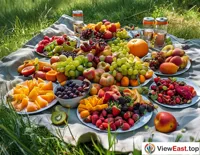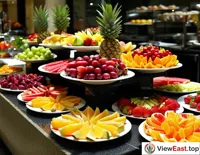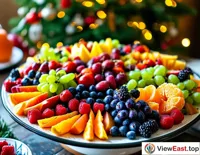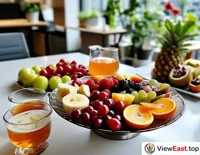







A: The Culture and Charm of Fruit Platter
Fruit platter, a visually striking and refreshingly tasty dish, is not only a feast for the eyes and palate but also a representation of the culture of healthy light meals. In the fast-paced modern life, people are increasingly focusing on a balanced diet and nutrition, making the fruit platter a preferred choice for a healthy lifestyle.
Cultural Background:
The fruit platter originated from ancient court banquets as a way for nobility to display luxury and taste. Over time, this refined dining culture has gradually entered the homes of ordinary people, becoming a beautiful feature on modern dining tables.
Suitable Groups:
Fruit platters are suitable for people of all ages, especially those who pursue a healthy lifestyle. For children, it provides rich nutrition for growth; for adults, it is an ideal choice for weight loss and maintaining figure; for the elderly, it is easy to digest and helps maintain a good digestive system.
Features and Taste:
The feature of fruit platters lies in their diverse combinations and color matching, which can be adjusted according to personal taste and seasonal changes. In terms of taste, it can be sweet, sour, or even slightly salty, making it appealing to different tastes.
Appearance:
In terms of appearance, fruit platters attract attention with their bright colors and exquisite shapes. By skillful cutting and arrangement, various shapes and patterns can be created, such as animals and flowers, which are both aesthetically pleasing and creative.
Nutritional Value:
The nutritional value of fruit platters lies in their rich vitamins and minerals. Different fruits contain different nutrients, such as vitamin C, potassium, dietary fiber, etc., which are beneficial for enhancing immunity, promoting digestion, and protecting cardiovascular health.
B: The Process of Making a Fruit Platter
Introduction to Ingredients:
The ingredients for making a fruit platter mainly include various seasonal fruits, such as apples, bananas, oranges, grapes, strawberries, blueberries, etc. Choosing fresh, brightly colored, and diversely flavored fruits can increase the appeal of the platter.
Tools Required:
The tools needed for making a fruit platter include: a sharp knife, a cutting board, a fruit plate, a fruit corer (optional), and decorative toothpicks or small forks.
Preparation of Ingredients:
Clean the fruits thoroughly and remove the skin or peel.
Depending on the need, cut the fruits into chunks, slices, or scoop them into balls.
For fruits that are prone to oxidation, such as apples and pears, apply lemon juice to the surface beforehand to prevent discoloration.
Cooking Steps:
Pair the prepared fruits according to color and shape.
Arrange the larger fruit pieces on the plate first, then gradually add smaller pieces.
Use a corer to create fruit balls for a three-dimensional effect.
Finally, sprinkle some crushed nuts or honey to enhance the flavor.
Seasoning Tips:
Add some honey or maple syrup to increase sweetness.
For those who prefer a sour taste, add some lemon juice or lime juice.
You can also add some mint leaves or basil leaves for a fresh taste.
Serving Suggestions:
1. It is best to make and eat the fruit platter immediately to maintain the best taste and nutrition.
2. It can be served as a dessert after a meal or as a healthy snack.